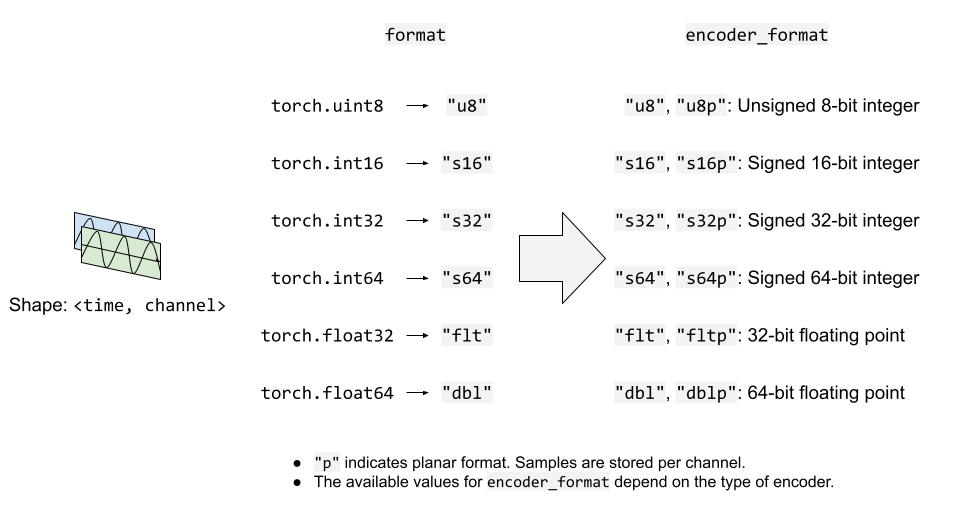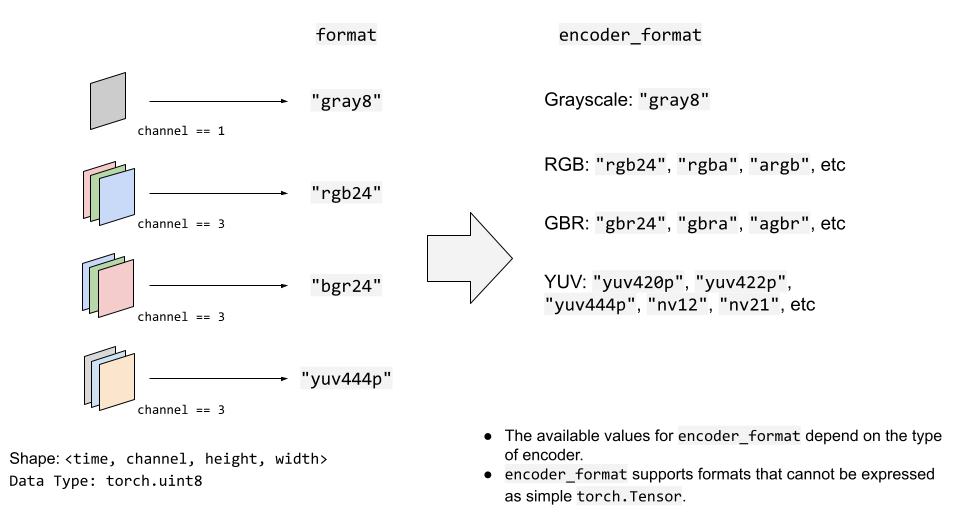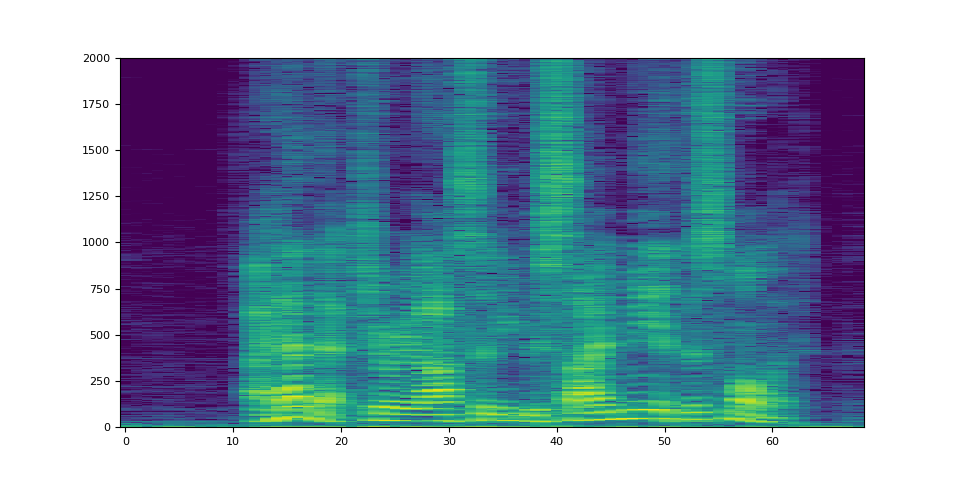注意
单击此处下载完整的示例代码
StreamWriter 基本用法¶
作者: Moto Hira
本教程介绍如何使用torchaudio.io.StreamWriter自
将音频/视频数据编码并保存为各种格式/目标。
注意
本教程需要 FFmpeg 库。 请参考 FFmpeg 依赖 细节。
警告
TorchAudio 动态加载兼容的 FFmpeg 库 已安装在系统上。 支持的格式类型(媒体格式、编码器、编码器 options 等)取决于库。
要检查可用的多路复用器和编码器,您可以使用 以下命令
ffmpeg -muxers
ffmpeg -encoders
制备¶
import torch
import torchaudio
print(torch.__version__)
print(torchaudio.__version__)
from torchaudio.io import StreamWriter
print("FFmpeg library versions")
for k, v in torchaudio.utils.ffmpeg_utils.get_versions().items():
print(f" {k}: {v}")
2.4.0
2.4.0
FFmpeg library versions
libavcodec: (60, 3, 100)
libavdevice: (60, 1, 100)
libavfilter: (9, 3, 100)
libavformat: (60, 3, 100)
libavutil: (58, 2, 100)
import io
import os
import tempfile
from IPython.display import Audio, Video
from torchaudio.utils import download_asset
SAMPLE_PATH = download_asset("tutorial-assets/Lab41-SRI-VOiCES-src-sp0307-ch127535-sg0042.wav")
WAVEFORM, SAMPLE_RATE = torchaudio.load(SAMPLE_PATH, channels_first=False)
NUM_FRAMES, NUM_CHANNELS = WAVEFORM.shape
_BASE_DIR = tempfile.TemporaryDirectory()
def get_path(filename):
return os.path.join(_BASE_DIR.name, filename)
基本用法¶
要使用 StreamWriter 将 Tensor 数据保存为媒体格式,请在此处 是三个必要的步骤
指定输出
配置流
写入数据
以下代码说明了如何将音频数据保存为 WAV 文件。
# 2. Configure the stream. (8kHz, Stereo WAV)
s.add_audio_stream(
sample_rate=SAMPLE_RATE,
num_channels=NUM_CHANNELS,
)
# 3. Write the data
with s.open():
s.write_audio_chunk(0, WAVEFORM)
Audio(path)
现在,我们更详细地了解每个步骤。
写入目标¶
StreamWriter 支持不同类型的写入目标
本地文件
类似文件的对象
流式处理协议(如 RTMP 和 UDP)
媒体设备(扬声器和视频播放器)†
† 对于媒体设备,请参考 StreamWriter 高级使用。
本地文件¶
StreamWriter 支持将媒体保存到本地文件。
StreamWriter(dst="audio.wav")
StreamWriter(dst="audio.mp3")
这也适用于静态图像和视频。
StreamWriter(dst="image.jpeg")
StreamWriter(dst="video.mpeg")
类似文件的对象¶
您还可以传递 file-lie 对象。类文件对象必须实现符合writeio.RawIOBase.write.
# Open the local file as fileobj
with open("audio.wav", "wb") as dst:
StreamWriter(dst=dst)
# In-memory encoding
buffer = io.BytesIO()
StreamWriter(dst=buffer)
流式处理协议¶
您可以使用流式处理协议流式传输媒体
# Real-Time Messaging Protocol
StreamWriter(dst="rtmp://localhost:1234/live/app", format="flv")
# UDP
StreamWriter(dst="udp://localhost:48550", format="mpegts")
配置输出流¶
指定目标后,下一步是配置流。 对于典型的音频和静止图像情况,只需要一个流, 但对于带音频的视频,至少需要两个流(一个用于音频,另一个用于 for video) 进行配置。
音频流¶
可以使用 method 添加音频流。add_audio_stream()
对于写入常规音频文件,至少 和 是必需的。sample_ratenum_channels
s = StreamWriter("audio.wav")
s.add_audio_stream(sample_rate=8000, num_channels=2)
默认情况下,音频流期望输入 waveform 张量为 type。
如果出现上述情况,数据将被编码成 WAV 格式的 detault 编码格式,
它是 16 位有符号整数线性 PCM。StreamWriter 在内部转换示例格式。torch.float32
如果编码器支持多种样本格式,并且您想要更改编码器样本格式,
您可以使用 OPTION。encoder_format
在以下示例中,StreamWriter 需要输入波形 Tensor 的数据类型
设置为 ,但它会在编码时将样本转换为 16 位有符号整数。torch.float32
s = StreamWriter("audio.mp3")
s.add_audio_stream(
...,
encoder="libmp3lame", # "libmp3lame" is often the default encoder for mp3,
# but specifying it manually, for the sake of illustration.
encoder_format="s16p", # "libmp3lame" encoder supports the following sample format.
# - "s16p" (16-bit signed integer)
# - "s32p" (32-bit signed integer)
# - "fltp" (32-bit floating point)
)
如果波形 Tensor 的数据类型不是 ,
您可以提供更改预期数据类型的选项。torch.float32format
以下示例将 StreamWriter 配置为预期 Tensor 类型。torch.int16
# Audio data passed to StreamWriter must be torch.int16
s.add_audio_stream(..., format="s16")
下图说明了 Options 的工作原理
用于音频流。formatencoder_format

视频流¶
如需添加静态图片或视频流,你可以使用 method。add_video_stream()
至少, , 和 是必需的。frame_rateheightwidth
s = StreamWriter("video.mp4")
s.add_video_stream(frame_rate=10, height=96, width=128)
对于静止图像,请使用 。frame_rate=1
s = StreamWriter("image.png")
s.add_video_stream(frame_rate=1, ...)
与音频流类似,您可以提供 and 选项来控制输入数据和编码的格式。formatencoder_format
以下示例以 YUV422 格式对视频数据进行编码。
s = StreamWriter("video.mov")
s.add_video_stream(
...,
encoder="libx264", # libx264 supports different YUV formats, such as
# yuv420p yuvj420p yuv422p yuvj422p yuv444p yuvj444p nv12 nv16 nv21
encoder_format="yuv422p", # StreamWriter will convert the input data to YUV422 internally
)
YUV 格式通常用于视频编码。许多 YUV 格式由色度
通道的平面大小与 luma 通道的平面大小不同。这使得
直接表示为 type。
因此,StreamWriter 会自动将输入的视频 Tensor 转换为目标格式。torch.Tensor
StreamWriter 期望输入图像张量为 4-D(时间、通道、高度、宽度)
和类型。torch.uint8
默认颜色通道为 RGB。即三个颜色通道,分别对应红色、绿色和蓝色。
如果您的输入具有不同的颜色通道,例如 BGR 和 YUV,则可以使用 option 指定它。format
以下示例指定 BGR 格式。
s.add_video_stream(..., format="bgr24")
# Image data passed to StreamWriter must have
# three color channels representing Blue Green Red.
#
# The shape of the input tensor has to be
# (time, channel==3, height, width)
下图说明了 Options 的工作原理
视频流。formatencoder_format

写入数据¶
配置流后,下一步是打开输出位置 并开始写入数据。
使用方法打开
destination 中,然后使用 and/or 写入数据。open()write_audio_chunk()write_video_chunk()
音频张量的形状应为 (time, channels), 视频/图像张量的形状应为 (time, channels, height, width)。
channels、height 和 width 必须与相应
stream,使用 option 指定。"format"
表示静止图像的 Tensor 在时间维度上必须只有一个帧, 但是音频和视频张量在时间维度上可以具有任意数量的帧。
以下代码片段对此进行了说明;
例) 音频¶
# Configure stream
s = StreamWriter(dst=get_path("audio.wav"))
s.add_audio_stream(sample_rate=SAMPLE_RATE, num_channels=NUM_CHANNELS)
# Write data
with s.open():
s.write_audio_chunk(0, WAVEFORM)
例)图像¶
# Image config
height = 96
width = 128
# Configure stream
s = StreamWriter(dst=get_path("image.png"))
s.add_video_stream(frame_rate=1, height=height, width=width, format="rgb24")
# Generate image
chunk = torch.randint(256, (1, 3, height, width), dtype=torch.uint8)
# Write data
with s.open():
s.write_video_chunk(0, chunk)
例) 无音频视频¶
# Video config
frame_rate = 30
height = 96
width = 128
# Configure stream
s = StreamWriter(dst=get_path("video.mp4"))
s.add_video_stream(frame_rate=frame_rate, height=height, width=width, format="rgb24")
# Generate video chunk (3 seconds)
time = int(frame_rate * 3)
chunk = torch.randint(256, (time, 3, height, width), dtype=torch.uint8)
# Write data
with s.open():
s.write_video_chunk(0, chunk)
例) 带音频的视频¶
要编写带音频的视频,必须配置单独的流。
# Configure stream
s = StreamWriter(dst=get_path("video.mp4"))
s.add_audio_stream(sample_rate=SAMPLE_RATE, num_channels=NUM_CHANNELS)
s.add_video_stream(frame_rate=frame_rate, height=height, width=width, format="rgb24")
# Generate audio/video chunk (3 seconds)
time = int(SAMPLE_RATE * 3)
audio_chunk = torch.randn((time, NUM_CHANNELS))
time = int(frame_rate * 3)
video_chunk = torch.randint(256, (time, 3, height, width), dtype=torch.uint8)
# Write data
with s.open():
s.write_audio_chunk(0, audio_chunk)
s.write_video_chunk(1, video_chunk)
逐个数据块写入数据¶
写入数据时,可以沿时间维度和 按较小的块写入它们。
# Write data in one-go
dst1 = io.BytesIO()
s = StreamWriter(dst=dst1, format="mp3")
s.add_audio_stream(SAMPLE_RATE, NUM_CHANNELS)
with s.open():
s.write_audio_chunk(0, WAVEFORM)
# Write data in smaller chunks
dst2 = io.BytesIO()
s = StreamWriter(dst=dst2, format="mp3")
s.add_audio_stream(SAMPLE_RATE, NUM_CHANNELS)
with s.open():
for start in range(0, NUM_FRAMES, SAMPLE_RATE):
end = start + SAMPLE_RATE
s.write_audio_chunk(0, WAVEFORM[start:end, ...])
# Check that the contents are same
dst1.seek(0)
bytes1 = dst1.read()
print(f"bytes1: {len(bytes1)}")
print(f"{bytes1[:10]}...{bytes1[-10:]}\n")
dst2.seek(0)
bytes2 = dst2.read()
print(f"bytes2: {len(bytes2)}")
print(f"{bytes2[:10]}...{bytes2[-10:]}\n")
assert bytes1 == bytes2
import matplotlib.pyplot as plt
bytes1: 10700
b'ID3\x04\x00\x00\x00\x00\x00"'...b'\xaa\xaa\xaa\xaa\xaa\xaa\xaa\xaa\xaa\xaa'
bytes2: 10700
b'ID3\x04\x00\x00\x00\x00\x00"'...b'\xaa\xaa\xaa\xaa\xaa\xaa\xaa\xaa\xaa\xaa'
示例 - Spectrum Visualizer¶
在本节中,我们使用 StreamWriter 创建频谱可视化 的音频并将其保存为视频文件。
为了创建频谱可视化,我们使用torchaudio.transforms.Spectrogram获取频谱表示
音频中,使用 matplotplib 生成其可视化的光栅图像,
然后使用 StreamWriter 将它们转换为包含原始音频的视频。
import torchaudio.transforms as T
准备数据¶
首先,我们准备 spectrogram 数据。
我们使用Spectrogram.
我们进行调整,使频谱图的一帧对应
设置为 1 个视频帧。hop_length
frame_rate = 20
n_fft = 4000
trans = T.Spectrogram(
n_fft=n_fft,
hop_length=SAMPLE_RATE // frame_rate, # One FFT per one video frame
normalized=True,
power=1,
)
specs = trans(WAVEFORM.T)[0].T
生成的频谱图如下所示。
spec_db = T.AmplitudeToDB(stype="magnitude", top_db=80)(specs.T)
_ = plt.imshow(spec_db, aspect="auto", origin="lower")

准备 Canvas¶
我们用来可视化每帧的频谱图。
我们创建一个辅助函数来绘制频谱图数据,并且
生成图形的光栅成像器。matplotlib
fig, ax = plt.subplots(figsize=[3.2, 2.4])
ax.set_position([0, 0, 1, 1])
ax.set_facecolor("black")
ncols, nrows = fig.canvas.get_width_height()
def _plot(data):
ax.clear()
x = list(range(len(data)))
R, G, B = 238 / 255, 76 / 255, 44 / 255
for coeff, alpha in [(0.8, 0.7), (1, 1)]:
d = data**coeff
ax.fill_between(x, d, -d, color=[R, G, B, alpha])
xlim = n_fft // 2 + 1
ax.set_xlim([-1, n_fft // 2 + 1])
ax.set_ylim([-1, 1])
ax.text(
xlim,
0.95,
f"Created with TorchAudio\n{torchaudio.__version__}",
color="white",
ha="right",
va="top",
backgroundcolor="black",
)
fig.canvas.draw()
frame = torch.frombuffer(fig.canvas.tostring_rgb(), dtype=torch.uint8)
return frame.reshape(nrows, ncols, 3).permute(2, 0, 1)
# sphinx_gallery_defer_figures
编写视频¶
最后,我们使用 StreamWriter 并写入视频。 我们一次处理 1 秒的音频和视频帧。
s = StreamWriter(get_path("example.mp4"))
s.add_audio_stream(sample_rate=SAMPLE_RATE, num_channels=NUM_CHANNELS)
s.add_video_stream(frame_rate=frame_rate, height=nrows, width=ncols)
with s.open():
i = 0
# Process by second
for t in range(0, NUM_FRAMES, SAMPLE_RATE):
# Write audio chunk
s.write_audio_chunk(0, WAVEFORM[t : t + SAMPLE_RATE, :])
# write 1 second of video chunk
frames = [_plot(spec) for spec in specs[i : i + frame_rate]]
if frames:
s.write_video_chunk(1, torch.stack(frames))
i += frame_rate
plt.close(fig)
/pytorch/audio/examples/tutorials/streamwriter_basic_tutorial.py:566: MatplotlibDeprecationWarning: The tostring_rgb function was deprecated in Matplotlib 3.8 and will be removed two minor releases later. Use buffer_rgba instead.
frame = torch.frombuffer(fig.canvas.tostring_rgb(), dtype=torch.uint8)
/pytorch/audio/examples/tutorials/streamwriter_basic_tutorial.py:566: UserWarning: The given buffer is not writable, and PyTorch does not support non-writable tensors. This means you can write to the underlying (supposedly non-writable) buffer using the tensor. You may want to copy the buffer to protect its data or make it writable before converting it to a tensor. This type of warning will be suppressed for the rest of this program. (Triggered internally at /opt/conda/conda-bld/pytorch_1720538440907/work/torch/csrc/utils/tensor_new.cpp:1544.)
frame = torch.frombuffer(fig.canvas.tostring_rgb(), dtype=torch.uint8)
结果¶
结果如下所示。
Video(get_path("example.mp4"), embed=True)
仔细观看视频,即可 观察到 “s” 的发音 (curiosity, besides, this) 有 在高频侧(视频右侧)分配了更多能量。
脚本总运行时间:(0 分 7.427 秒)